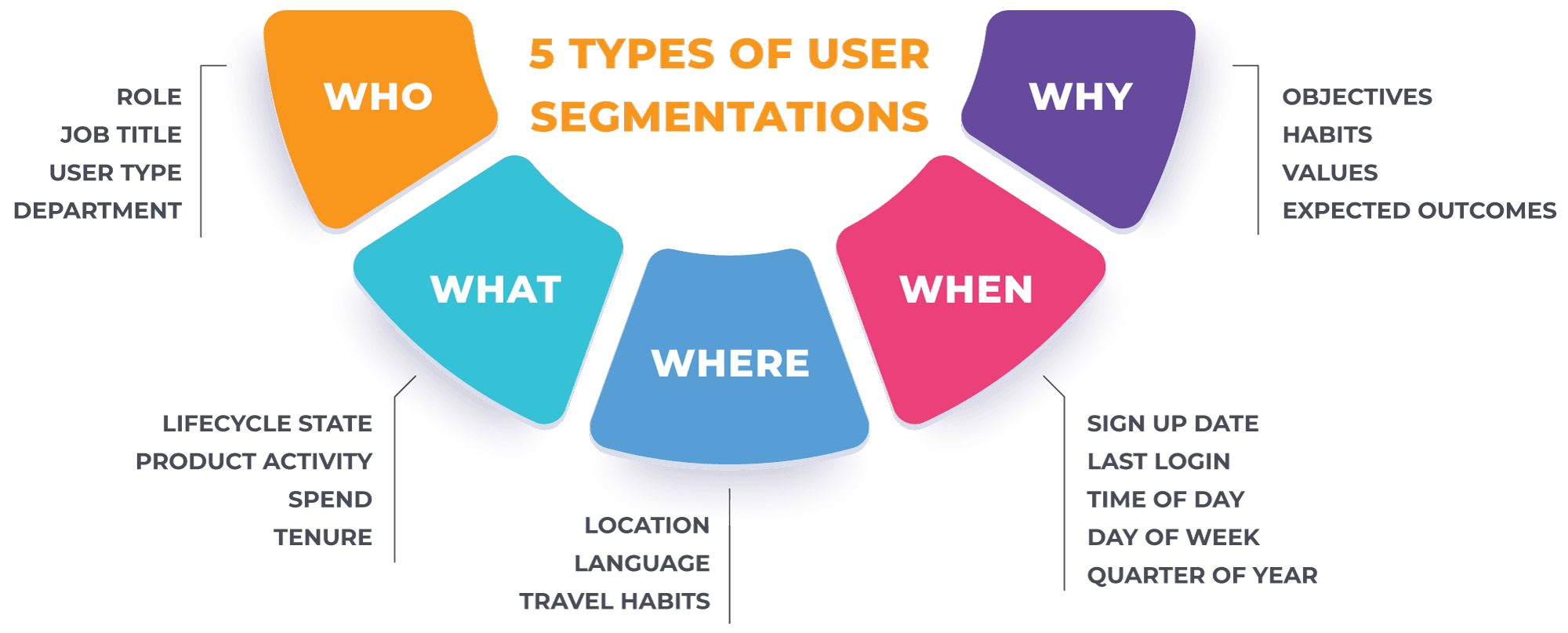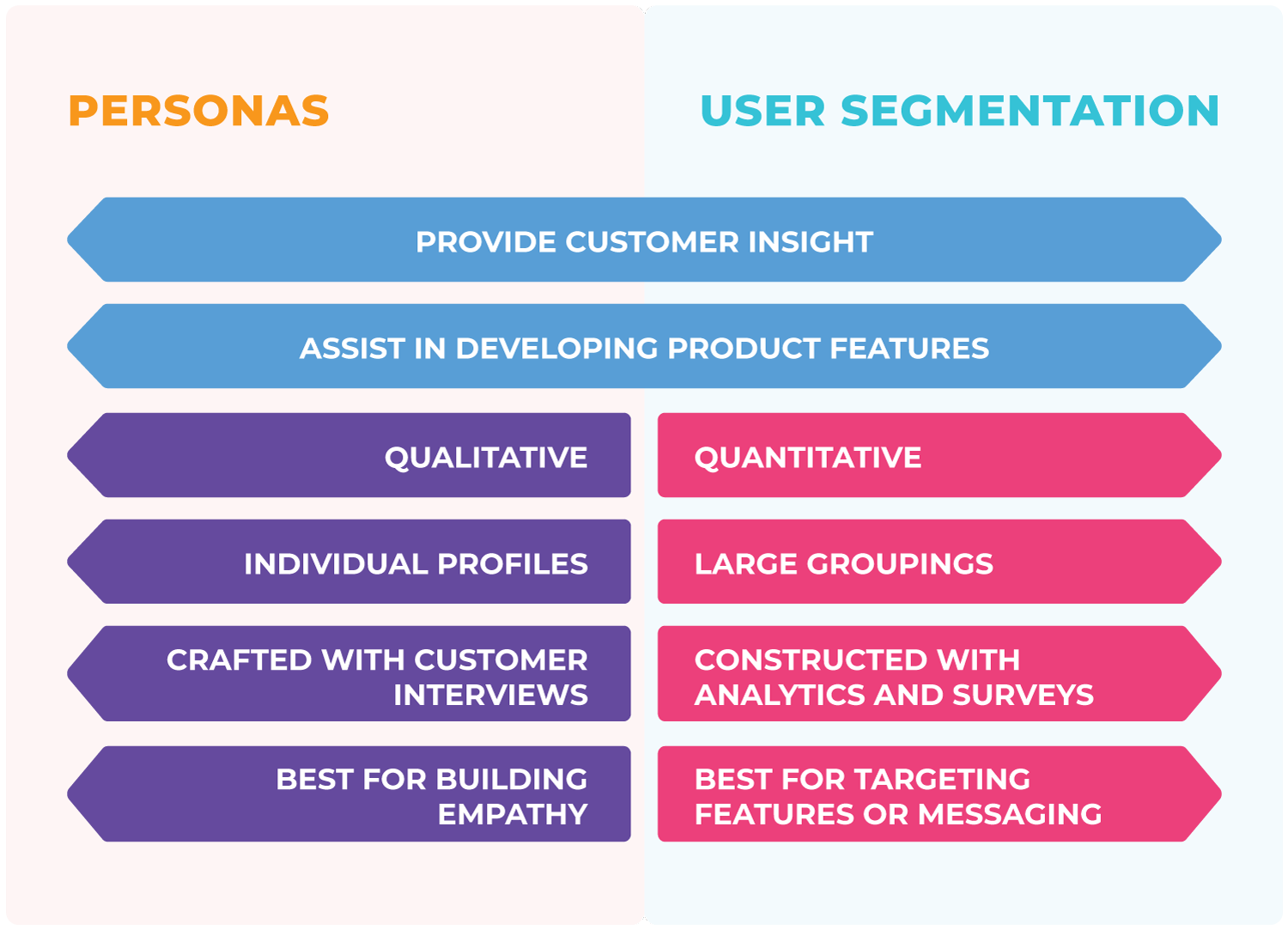User Segmentation: Best Practices & Examples
Do you still think user segmentation only matters to the marketing team? Think again.
Maybe you’ve overheard the term “user segmentation” in a meeting and wondered what it meant. Perhaps you’ve even asked yourself if it was something your team should use. The answer is an emphatic “yes!”
User segmentation, also known as customer segmentation, is the process of grouping users of your product by common characteristics. These groupings might include demographics, behaviors, locations, or even their habits and desires. Sound familiar? User segmentation has a lot in common with the process of creating personas. Just like user segments, personas have characteristics that represent a particular group of your users. However, there are fundamental differences, and we’ll learn why both are valuable tools for the product team, whether you’re involved with product design or product management.

Image showing different segmentation types and attributes
There are five basic types of user segmentations. You can think of them as Who, What, Where, When, and Why.
Who Are Your Users?
Also known as demographics, PMs managing products targeted for business use, group their users by role, job title, department and other similar characteristics. Demographic segmentation is generally best used in combination with another segmentation type and may include:
- Role
- Job title
- User type
- Department
What Do Your Users Do?
A behavioral segmentation addresses how your users interact with your product. How much are they willing to spend? How long do they typically use it? Are these new customers or have they been using your product for a long time? This type of segmentation can significantly impact product messaging and placement. Example criteria of a behavioral segmentation include:
- Lifecycle stage
- Product activity
- Overall spend
- Tenure (the length of time they remain a customer)
Where Do Your Users Live?
The geographic segmentation is just what it sounds like: grouping your users by their location on the globe, their culture, and the language they speak. For some software products, this may also include whether or not your customer is a remote worker. In this segmentation, users are typically grouped by:
- Geographic location (both home and work)
- Preferred language
- Travel habits
When Do Users Engage with Your Product?
The occasional segmentation, as it’s referred to, groups users by when they interact with your product. For instance, if you’re building educational software, you might see peak engagement at the start of the school year. Online retailers can expect a massive spike in purchases around the holiday season, but may see smaller weekly jumps on Sundays and Mondays. Productivity tools geared towards office workers will likely experience more usage on weekdays vs. weekends. Parameters of the occasional segmentation that you might consider segmenting by are:
- Sign up date
- Date of last login
- Time of day
- Day of week
- Quarter of year
Why Do Your Customers Use Your Product?
Segmenting users based on psychographics may be trickiest to achieve, but can provide some powerful insights. This type of segmentation looks at what motivates your customers to purchase and engage with your product. For B2B products, typical categories might include a user’s:
- Objectives
- Habits
- Values
- Expected outcomes
As we have seen, there are many ways to group and define your customers. You may already be familiar with creating customer definitions as a designer or product manager. You probably refer to them as “personas,” and you might wonder how persona creation differs from customer segmentation.
User Segmentation Versus User Personas
Customer segmentation and personas are valuable for gaining insight into your users, but they have some key differences. Segmentation uses large-scale quantitative research, such as analytics data and surveys, to build broad groupings of users. Personas are generally crafted with the help of qualitative user interviews and focus on creating individual user profiles that may cut across multiple customer segments. You can make the best use of personas with activities meant to generate user empathy and deeper insight into behavior. Segmentation can help in more tactical ways, such as message targeting or feature development.
When used together, segmentation and personas can help you identify opportunities in your product and then generate design solutions to make the most of them.

Image shows segmentation vs. personas
Getting Started with User Segmentation
Establish Goals
As you would when starting any new project, the first step in defining your user segments is to outline your business goal. Perhaps you’re focused on growth and would like to improve your product’s onboarding experience to convert more trial customers to paid subscribers. Maybe you’d like to increase engagement with a specific feature. Defining the purpose of your user segmentation will help you identify what segments and data you’ll need and the research methods you’ll use to gather that data.
Once you’ve established your business goals, you can define KPIs (Key Performance Indicators) to measure your segmentation strategy’s success. KPIs are metrics targets based on your business goals. Let’s say your goal is to increase engagement with a feature. One possible KPI might be to increase daily user sessions for that feature by 10%. Platforms like Gainsight PX can enable your segmentation strategy by allowing you to establish and track KPIs.
Craft a User Journey
The intersection of your user segments and customer personas will give your product superpowers! Now you’re able to craft user journey maps to illustrate crucial interaction points with your product, based on specific customer personas. For instance, determining when in their journey a trial persona is most likely to feel successful and confident can help inform placement and timing of subscription callouts. Crafting a customer journey to identify these opportunities is an excellent time to engage your cross-functional stakeholders. Consider bringing together your product, engineering, and marketing teams for this exercise.
Once your core customer journey has been mapped out, work with your stakeholders to identify one to two key opportunities in the journey. Look for high-value, high-impact events. Identifying opportunities like peak usage times or critical lifecycle stages will assist you in creating user segments that maximize those key opportunities.
Gather Data
Now that we know where customer journeys are leading, and we’ve identified the goals of our segments, we need to gather data on each segment. If you have an internal data team, reach out to them and explain your goals. It’s great if they can help you retrieve the customer data you need, but it’s even better if you can leverage customer insight tools to create segments on your own, as they may change over time. Learning to use platforms like Gainsight PX will provide both short-term benefits to your current project and add new skills to your PM toolbox.
In addition to behavioral or demographic metrics collected by your analytics tools, you may need more specific data. For example, gathering psychographic attributes might require communicating directly with customers. In this case, products like Gainsight can help you run targeted surveys to gather the insights you need.
With user segments, data, and goals in hand, you now have what you need to outline a targeted and measurable outcome. Suppose your goal is to convert trial users to paid subscribers and you know that users who are individual contributors tend to have higher engagement levels. With this insight, you can focus on generating feature ideas for this demographic.
Avoiding Common Pitfalls
Rely on Data, Not Intuition
As you get started with user segmentation, you may already have a rough idea of what segments exist for your product and which to target. However, don’t mistake intuition or even internal knowledge for concrete data. Partnering with the data team and putting analytics tools to good use is a critical step of the process. In addition, using customer interviews alone won’t provide enough statistical significance to create user segments.
Once you’ve accessed the data and used it to define user groupings, take a second and third look at the segments you’ve created. Are any of them similar? It’s typically better to have a broader set of segments that combine similar customers. A narrow approach may lead you to miss a vital target and result in a strategy that is spread too thin.
Don’t Do It Alone
Internal collaboration is a great way to validate segments and ensure you’re headed in the right direction. Don’t keep your user segments to yourself! Consider presenting your findings to other teams within the company. Communicating and sharing more broadly with your peers in marketing, business development, and sales can get you much-needed insights and second opinions. Oftentimes, these teams benefit from PM segmentation exercises, which can bring new perspectives to their work. You can also get validation and feedback from departments that interface directly with users, including your customer success and support teams. Do they see similar patterns in the customers they talk to every day? Are there any patterns they’ve noticed that you may have missed?
Using verifiable data to create your segments, keeping them broad, and sharing your findings with other teams are all essential ways to validate and refine your user segmentation strategy.
Let’s Recap What We Learned
User segmentation, the process of grouping customers into broad categories, is a technique that provides value for more than just marketing purposes. By incorporating user segmentation into your product design or product management strategy, you’ll have a powerful tool to help you capitalize on critical opportunities. Combining quantitative user segments with qualitative user personas allows you to target features and measure their success in the real world. Building partnerships with your data team and sharing your findings with the broader company unlocks all these benefits (and more). So go forth and segment!



